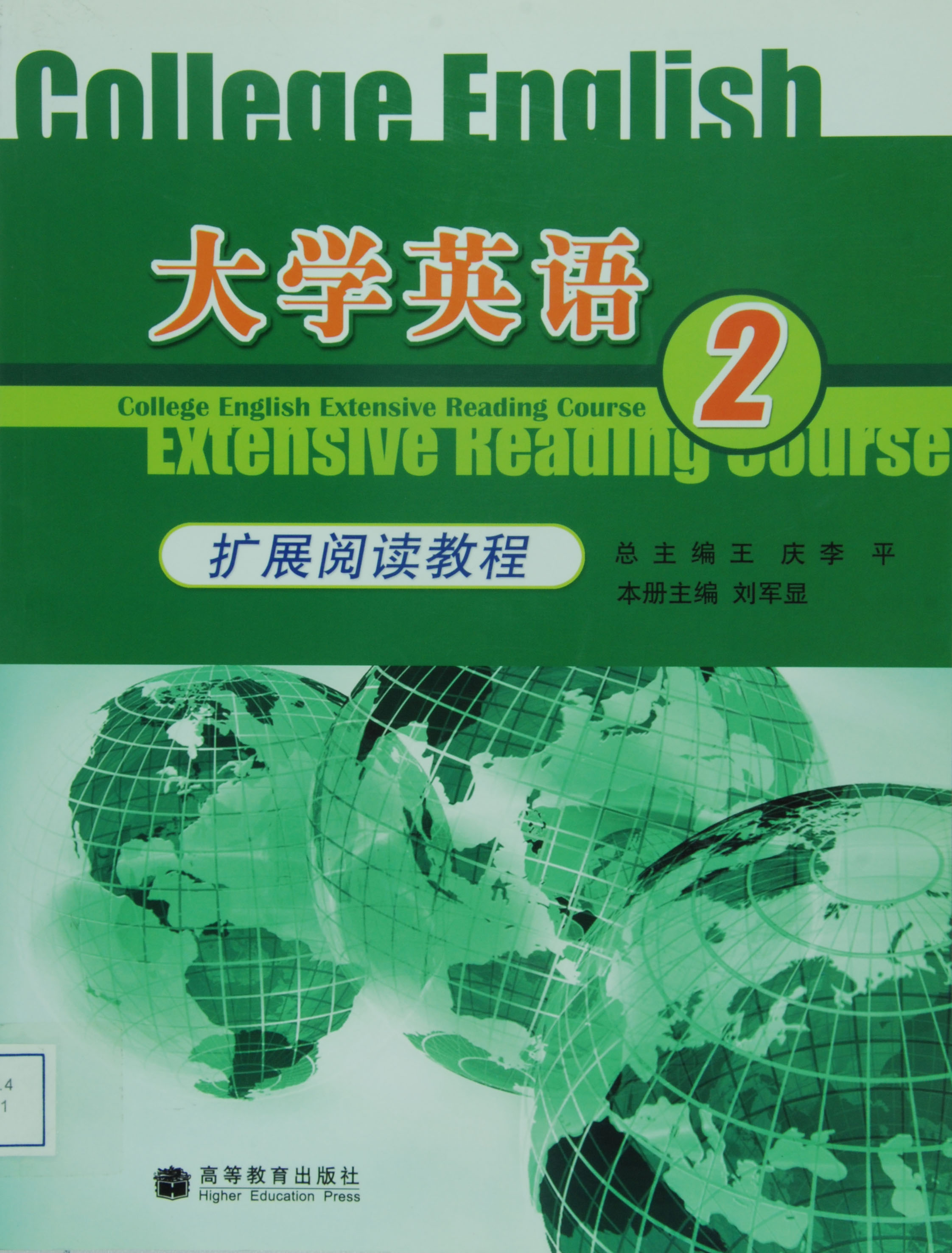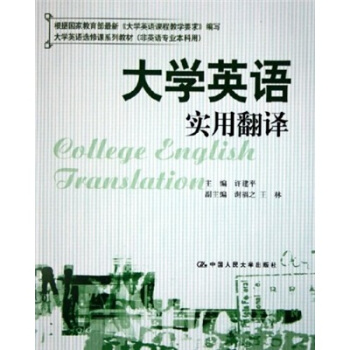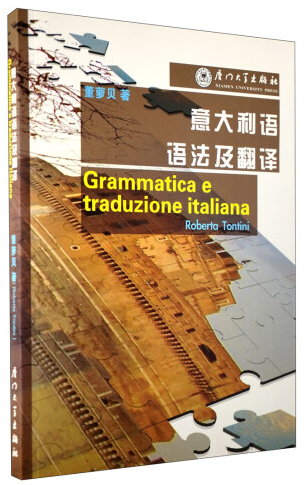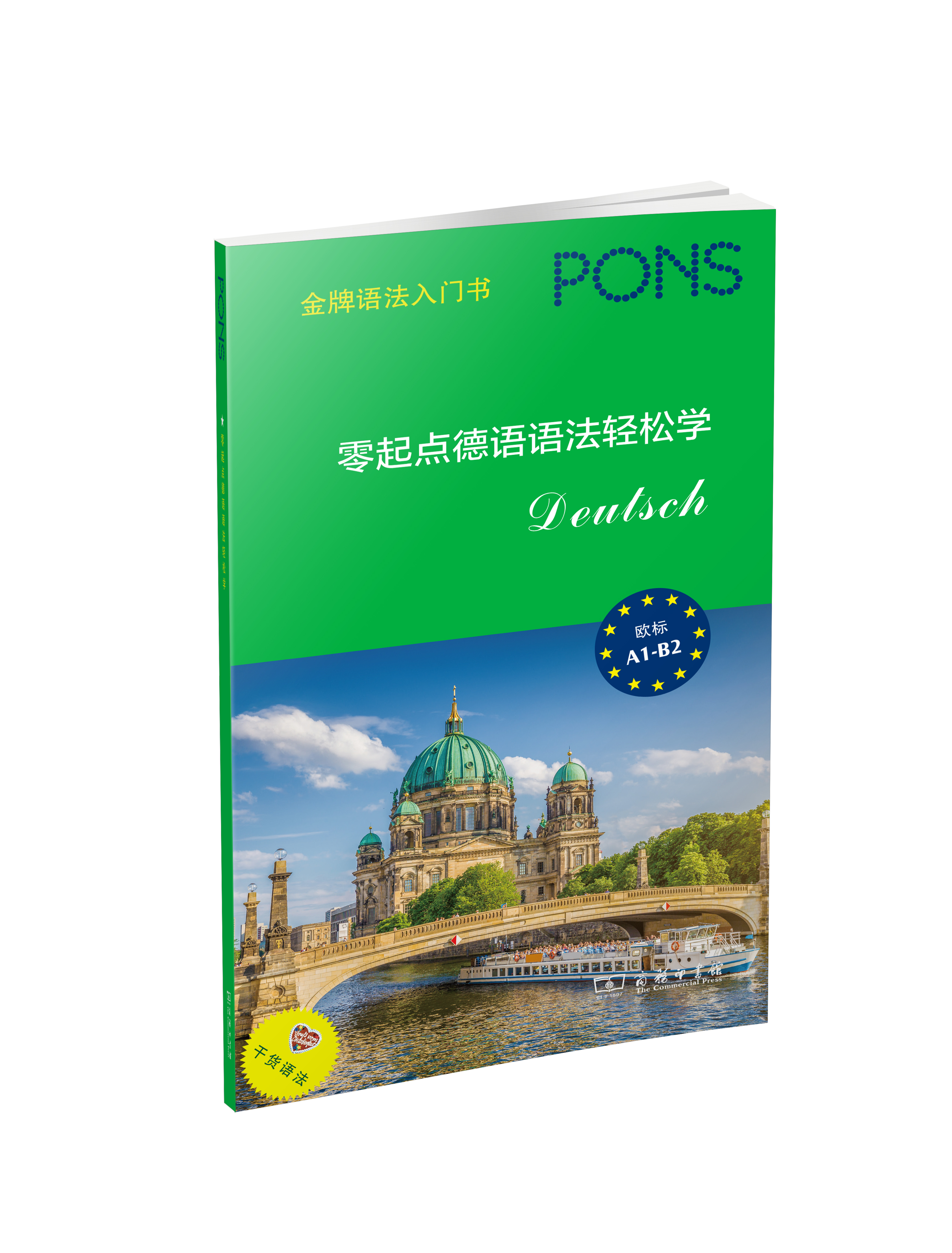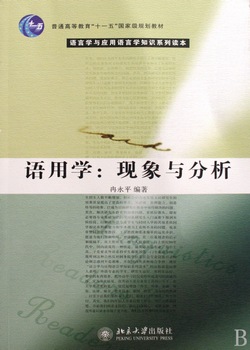英汉互译实践与技巧(第五版)(高校英语选修课系列教材)
定价:¥59.00
作者: 许建平
出版时间:2018-05
出版社:清华大学出版社
- 清华大学出版社
- 9787302501145
- 5-1
- 208122
- 42190128-1
- 16开
- 2018-05
- 492
- H315.9
- 英语
- 本科
内容简介
本书是为非英语专业的大学生及研究生编写的英汉互译教程。其主要内容包括:翻译基本理论
知识与原则;常用翻译方法、技能与技巧;实用英汉互译训练和指导;有针对性的各类文体英汉互
译独立练习。本教材内容经过清华大学等众多高校课堂教学长期反复使用,效果良好。所有练习均
附有参考译文,便于自学。
本书亦可供有志于提高翻译技能并具有中等以上水平的自学者使用。
知识与原则;常用翻译方法、技能与技巧;实用英汉互译训练和指导;有针对性的各类文体英汉互
译独立练习。本教材内容经过清华大学等众多高校课堂教学长期反复使用,效果良好。所有练习均
附有参考译文,便于自学。
本书亦可供有志于提高翻译技能并具有中等以上水平的自学者使用。
目录
Unit 1 Introduction: Translation and Translation Techniques
绪论:翻译与翻译技巧 . 1
Practice of the Relevant Skill 相关翻译技巧训练 . 1
I. Important Role of Translation 翻译的重要作用 4
II. Nature and Scope of Translation 翻译的性质和范围 5
III. Principles or Criteria of Translation 翻译的原则标准 . 6
IV. Literal Translation and Free Translation 直译与意译 . 7
V. Translation Techniques 翻译技巧种种 .10
Re ections and Practice 思考与练习 .11
Unit 2 Diction 遣词用字 15
Practice of the Relevant Skill 相关翻译技巧训练 .15
I. Equivalence Between English and Chinese at Word Level
英汉字词层面的对等关系20
1. Word-for-Word Equivalence 字词对等 20
2. One Word with Multiple Equivalents of the Same Meaning 多词同义 .20
3. One Word with Several Equivalents of Different Meanings 一词多义 .21
4. Equivalents Interwoven with One Another 词义交织 .21
5. Words Without Corresponding Equivalents 无对等词语 21
II. Methods to Make out the Meaning of a Given Word 英语词义辨析法 22
1. Judging by Word Formation 通过构词法确定词义 22
2. Judging by References 通过指代关系确定词义 .22
3. Judging by Context and Collocation
通过上下文及习惯搭配确定词义 .23
4. Judging by Branches of Learning and Specialties
按不同学科或专业门类确定词义 .24
III. Techniques of Translating a Given English Word 英语词语翻译技巧 24
1. Deduction 推演法 24
2. Transplant 移植法 .25
3. Extension 引申法 25
4. Substitution 替代法 25
5. Explanation 释义法 .25
6. Combination 合并法 26
7. Transliteration 音译法 26
8. Pictographic Translation 图形法 26
IV. Diction in C-E Translation 汉译英的选词用字26
Re ections and Practice 思考与练习 .28
Uuit 3 Conversion 转换.31
Practice of the Relevant Skill 相关翻译技巧训练 .32
I. Conversion in E-C Translation 英译汉的词类转换 35
1. Converting into Verbs 转换成动词 .35
2. Converting into Nouns 转换成名词 .36
3. Converting into Adjectives 转换成形容词 37
4. Converting into Adverbs 转换成副词 .38
5. The Conversion of Sentence Elements 句子成分转换 .38
II. Conversions in C-E Translation 汉译英的词类转换39
1. Converting Verbs into Other Parts of Speech 汉语动词转换成其他词类 .39
2. Conversions Between Different Parts of Speech 各种词类相互转换 .40
Re ections and Practice 思考与练习 .41
Unit 4 Ampli cation 增添法 .43
Practice of the Relevant Skill 相关翻译技巧训练 .44
I. Ampli cation in E-C Translation 增词法在英汉翻译中的运用 48
1. Putting in Words Omitted in the Original 加入原文所省略的词语 48
2. Putting in Necessary Connectives 加入必要的连接词语 48
3. Putting in Words to Convey the Concept of Plurality 增词以表达复数概念 .48
4. Putting in Words to Indicate Different Tenses or Sequences
增词以表现不同的时态或先后顺序 .48
5. Amplification by Common Sense 常识性增词 49
6. Amplification for the Purpose of Rhetoric or Coherence 修辞性或连贯性增词 .49
7. Amplification by Repetition 重复性增词 49
II. Ampli cation in C-E Translation 增词法在汉英翻译中的运用 .49
1. Adding Necessary Pronouns 增添必要的代词 49
2. Adding Necessary Articles 增添必要的冠词 .50
3. Adding Necessary Connectives 增添必要的连接词语 50
4. Adding Necessary Prepositions 增添必要的介词 50
5. Adding Necessary Background Words 增添必要的背景词语 .50
Re ections and Practice 思考与练习 .51
Unit 5 Omission 省略法 53
Practice of the Relevant Skill 相关翻译技巧训练 .54
I. Omission in E-C Translation 省略法在英汉翻译中的运用 57
1. Omitting the Pronoun 省略代词 57
2. Omitting the Article 省略冠词 .57
3. Omitting the Preposition 省略介词 57
4. Omitting the Conjunction 省略连词 58
5. Omitting the Verb 省略动词 58
6. Omitting the Impersonal Pronoun”It”省略非人称代词”It” 58
II. Omission in C-E Translation 省略法在汉英翻译中的运用 .59
1. Omitting Redundant Words 省略冗词赘语 .59
2. Omitting Words of Conceptual Category 省略概念范畴类词语 59
3. Omitting Meticulous Descriptions 省略过详的细节描述 .59
Re ections and Practice 思考与练习 .60
Unit 6 Restructuring 结构调整 .63
Practice of the Relevant Skill 相关翻译技巧训练 .64
I. Di erent Word Orders in English and Chinese 英汉语言的词序差异 67
1. Different Modes of Thinking 不同的思维模式.67
2. Different Inversion Structures 不同的倒装结构 68
II. Restructuring in E-C Translation 英汉翻译的结构调整 .69
1. Keeping the Original Sequence 保持原文顺序 .69
2. Reversing the Original Sequence 颠倒原文顺序 .70
3. Restructuring by Time Sequence 按时间顺序调整 70
4. Restructuring by Logical Sequence 按逻辑顺序调整 .70
III. Restructuring in C-E Translation 汉英翻译的结构调整 71
1. Different Sequences in Customary Word Combinations
不同的词语习惯表达顺序 71
2. Cases of Restructuring in C-E Translation 汉英翻译的结构调整情况 71
Re ections and Practice 思考与练习 .72
Unit 7 Affirmative vs. Negative 肯定与否定 75
Practice of the Relevant Skill 相关翻译技巧训练 .76
I. Negation in E-C Translation 英译汉的正反调换 79
1. Affirmative in English, but Negative in Chinese 英语为肯定,汉语译作否定 80
2. Negative in English, but Affirmative in Chinese 英语为否定,汉语译作肯定 80
3. Same English Wording, Either Affirmative or Negative in Chinese
译作肯定否定均可 81
4. Double Negative for Emphasis 强调性双重否定 .81
5. Roundabout Affirmative 间接式肯定 .81
6. Some Traps in Negative Structures 否定的陷阱 82
II. Negation in C-E Translation 汉译英的正反调换 .83
1. Negation According to English Usage 按英语表达习惯译作肯定或否定.83
2. Negation for Emphasis or Rhetorical Effect
从强调或修辞角度考虑译作肯定或否定 .83
3. Negation to Convey Exactly the Original Meaning
用正反调换传达出原文的确切意思 .83
Re ections and Practice 思考与练习 .84
Unit 8 The Passive Voice 被动语态 .87
Practice of the Relevant Skill 相关翻译技巧训练 .87
I. The Passive Voice in E-C Translation 英汉翻译的被动语态 91
1. Converting the Passive Voice into the Active 将被动语态转为主动结构 .91
2. Converting the Passive Voice into a Subjectless Sentence
将被动语态转为无主句 .92
3. Keeping the Passive Structure Unchanged 被动语态保持不变 .92
4. Replacing the Passive Voice with Other Means 用其他手段代替被动语态 93
II. Passive Structures in C-E Translation 汉英翻译的被动结构 .93
1. Chinese Sentences with Passive Labels 带有被动标签的汉语句子 .94
2. Chinese Sentences Without Passive Labels 不带被动标签的汉语句子 .94
3. Converting the Active Structure into the Passive Voice
将主动结构转换为被动语态 94
4. The Translation of Some Idiomatic Chinese Expressions
一些汉语习惯表达的翻译套路 95
Re ections and Practice 思考与练习 .95
Unit 9 Nominal Clauses 名词性从句 .99
Practice of the Relevant Skill 相关翻译技巧训练 .99
I. The Translation of English Nominal Clauses 英语名词性从句的翻译 103
1. Subject Clauses 主语从句 . 103
2. Object Clauses 宾语从句 103
3. Predicative Clauses 表语从句 . 104
4. Appositive Clauses 同位语从句 104
II. The Translation of Chinese Complex Sentences 汉语复句的翻译 105
1. Sentence Combination 句子的合并 105
2. Sentence Sequence 句序 106
Re ections and Practice 思考与练习 .107
Unit 10 Attributive Clauses 定语从句 110
Practice of the Relevant Skill 相关翻译技巧训练 .111
I. A Comparative Study of English and Chinese Attributive Structures
英汉定语结构的对比 113
II. Restrictive Attributive Clauses 限制性定语从句 114
1. Combination 合并法 . 114
2. Division 分译法 . 115
3. Mixture 混合法 115
III. Non-Restrictive Attributive Clauses 非限制性定语从句 116
1. Division 分译法 . 116
2. Combination 合并法 . 117
IV. Attributive Clauses Functioning as Adverbials 兼有状语功能的定语从句 117
1. Translating into Adverbial Clauses of Cause 译作原因句 . 118
2. Translating into Adverbial Clauses of Result 译作结果句 . 118
3. Translating into Adverbial Clauses of Concession 译作让步句 . 118
4. Translating into Adverbial Clauses of Condition 译作条件句 118
5. Translating into Adverbial Clauses of Purpose 译作目的句 119
Re ections and Practice 思考与练习 .119
Unit 11 Adverbial Clauses 状语从句 122
Practice of the Relevant Skill 相关翻译技巧训练 .122
I. The Translation of English Adverbial Clauses 英语状语从句的翻译 124
1. Adverbial Clauses of Time 时间状语从句 . 125
2. Adverbial Clauses of Place 地点状语从句 125
3. Adverbial Clauses of Cause 原因状语从句 126
4. Adverbial Clauses of Condition 条件状语从句 . 126
5. Adverbial Clauses of Concession 让步状语从句 . 126
6. Adverbial Clauses of Purpose 目的状语从句 . 127
II. Adverbial Clauses in Chinese Complex Sentences 汉语复句中的状语分句 127
1. Discerning Subordination 分清主次关系 127
2. Using Inanimate Subjects 使用无灵主语 . 127
Re ections and Practice 思考与练习 .128
Unit 12 Long Sentences 长句 .131
Practice of the Relevant Skill 相关翻译技巧训练 .132
I. Long Sentences in E-C Translation 英汉翻译的长句处理 134
1. Two Stages and Five Steps 长句翻译的两个阶段和五个步骤 . 134
2. Sample Analysis 长句分析示例 134
II. Methods of Translating Long English Sentences 英译汉长句的翻译方法 .136
1. Embedding 内嵌法 136
2. Dividing 切分法 137
3. Splitting 拆分法 138
4. Inserting 插入法 . 139
5. Recasting 重组法 . 139
III. Long Sentences in C-E Translation 汉译英的长句处理 140
Re ections and Practice 思考与练习 .142
Unit 13 English for Science and Technology and Its Translation
科技英语及其翻译 146
Practice of the Relevant Skill 相关翻译技巧训练 .146
I. Formation of English Technical Terms 英语科技词语的构成 149
1. Affixation 缀合法 . 149
2. Compounding 复合法 . 150
3. Blending 缩合法 . 150
4. Acronyms 首字母缩略 . 150
5. Proper Nouns 专有名词 151
II. Characteristic Syntax of EST 科技英语的句法特点 152
ng and Complicated Sentences 使用结构复杂长句 . 152
2. High Frequency of Noun Phrases 频繁使用名词短语 . 153
3. Extensive Use of the Passive Voice 广泛使用被动语态 . 153
4. More Non-Finite Forms of the Verb 多使用非限定动词 . 153
5. Different Uses of the Tense 时态的使用差异 154
6. The Post-Position of the Attributive 定语后置 . 154
III. Methods of Translating EST 科技英语的翻译方法 155
1. Expanding Noun Phrases into Separate Clauses
将名词性短语扩展成汉语分句 . 155
2. Converting Noun Phrases into Verb-Object Structures
将名词性短语转换成动宾结构 . 155
3. Converting Attributive Elements into Independent Sentences,
Adverbial Clauses, etc. 将定语成分转换成独立句、状语分句等 . 155
4. Converting the Passive into the Active 将被动转换成主动 . 155
5. Supplementing Necessary Words to Indicate Given Time
补充适当的词语表示特定的时间 156
Re ections and Practice 思考与练习 .156
Unit 14 The Translation of Documentation 文献的翻译 .159
Practice of the Relevant Skill 相关翻译技巧训练 .160
I. The Translation of Contracts and Agreements 合同与协议的翻译 162
II. The Translation of Proposals, Reports and Reviews
建议、报告与评论的翻译164
III. The Translation of Patents and Trademarks 专利与商标的翻译.166
IV. The Translation of Copyright Documents 版权文献的翻译 168
V. The Translation of Bid-Documents 招标文献的翻译 .169
VI. The Translation of Abstracts, Indexes and Bibliographies
摘要、索引与文献目录的翻译 .171
Re ections and Practice 思考与练习 .174
Unit 15 Application Documents for Studying Abroad
出国留学申请翻译 179
Practice of the Relevant Skill 相关翻译技巧训练 .179
I. Orienting Your Target 留学目标定位 .181
II. Résumé (Curriculum Vitae) 个人简历(履历) 182
III. School Transcript (Academic Record) 学习成绩单 .185
IV. Letters of Recommendation 推荐信 .188
V. Personal Statement (Statement of Purpose) 自我陈述 190
Re ections and Practice 思考与练习 .194
Unit 16 Developing Comprehensive Abilities Through Comparative
Studies and Practice
通过比较研究与实践培养翻译综合能力 197
Practice of the Relevant Skill 相关翻译技巧训练 .198
I. A Comparative Study of English and Chinese Languages 英汉语言宏观对比 .200
1. Synthetic vs. Analytic 综合性与分析性 . 200
2. Compact vs. Diffusive 紧凑与松散 201
3. Hypotactic vs. Paratactic 形合与意合 201
4. Complex vs. Simplex 繁复与简单 201
5. Impersonal vs. Personal 物称与人称 202
6. Passive vs. Active 被动与主动 202
7. Static vs. Dynamic 静态与动态 203
8. Abstract vs. Concrete 抽象与具体 . 203
9. Roundabout vs. Straightforward 间接与直接 203
bstitutive vs. Repetitive 替换与重复 . 203
II. Developing Practical Abilities Through Comparative Studies and Practice
通过比较研究和实践提高翻译动手能力 .204
1. Language Sensibility 语感能力 . 204
2. Contextual Analysis 语境分析能力 205
3. Logical Thinking 逻辑思维能力 207
Re ections and Practice 思考与练习 .209
Appendix A Translation Exercises for Independent Work
英汉互译独立作业练习 .212
Appendix B Keys to Practice of the Relevant Skill and Exercises
相关翻译技巧及练习答案 .248
Appendix C Keys to Translation Exercises for Independent Work
英汉互译独立作业练习参考译文 .301
Bibliography 参考文献 335
绪论:翻译与翻译技巧 . 1
Practice of the Relevant Skill 相关翻译技巧训练 . 1
I. Important Role of Translation 翻译的重要作用 4
II. Nature and Scope of Translation 翻译的性质和范围 5
III. Principles or Criteria of Translation 翻译的原则标准 . 6
IV. Literal Translation and Free Translation 直译与意译 . 7
V. Translation Techniques 翻译技巧种种 .10
Re ections and Practice 思考与练习 .11
Unit 2 Diction 遣词用字 15
Practice of the Relevant Skill 相关翻译技巧训练 .15
I. Equivalence Between English and Chinese at Word Level
英汉字词层面的对等关系20
1. Word-for-Word Equivalence 字词对等 20
2. One Word with Multiple Equivalents of the Same Meaning 多词同义 .20
3. One Word with Several Equivalents of Different Meanings 一词多义 .21
4. Equivalents Interwoven with One Another 词义交织 .21
5. Words Without Corresponding Equivalents 无对等词语 21
II. Methods to Make out the Meaning of a Given Word 英语词义辨析法 22
1. Judging by Word Formation 通过构词法确定词义 22
2. Judging by References 通过指代关系确定词义 .22
3. Judging by Context and Collocation
通过上下文及习惯搭配确定词义 .23
4. Judging by Branches of Learning and Specialties
按不同学科或专业门类确定词义 .24
III. Techniques of Translating a Given English Word 英语词语翻译技巧 24
1. Deduction 推演法 24
2. Transplant 移植法 .25
3. Extension 引申法 25
4. Substitution 替代法 25
5. Explanation 释义法 .25
6. Combination 合并法 26
7. Transliteration 音译法 26
8. Pictographic Translation 图形法 26
IV. Diction in C-E Translation 汉译英的选词用字26
Re ections and Practice 思考与练习 .28
Uuit 3 Conversion 转换.31
Practice of the Relevant Skill 相关翻译技巧训练 .32
I. Conversion in E-C Translation 英译汉的词类转换 35
1. Converting into Verbs 转换成动词 .35
2. Converting into Nouns 转换成名词 .36
3. Converting into Adjectives 转换成形容词 37
4. Converting into Adverbs 转换成副词 .38
5. The Conversion of Sentence Elements 句子成分转换 .38
II. Conversions in C-E Translation 汉译英的词类转换39
1. Converting Verbs into Other Parts of Speech 汉语动词转换成其他词类 .39
2. Conversions Between Different Parts of Speech 各种词类相互转换 .40
Re ections and Practice 思考与练习 .41
Unit 4 Ampli cation 增添法 .43
Practice of the Relevant Skill 相关翻译技巧训练 .44
I. Ampli cation in E-C Translation 增词法在英汉翻译中的运用 48
1. Putting in Words Omitted in the Original 加入原文所省略的词语 48
2. Putting in Necessary Connectives 加入必要的连接词语 48
3. Putting in Words to Convey the Concept of Plurality 增词以表达复数概念 .48
4. Putting in Words to Indicate Different Tenses or Sequences
增词以表现不同的时态或先后顺序 .48
5. Amplification by Common Sense 常识性增词 49
6. Amplification for the Purpose of Rhetoric or Coherence 修辞性或连贯性增词 .49
7. Amplification by Repetition 重复性增词 49
II. Ampli cation in C-E Translation 增词法在汉英翻译中的运用 .49
1. Adding Necessary Pronouns 增添必要的代词 49
2. Adding Necessary Articles 增添必要的冠词 .50
3. Adding Necessary Connectives 增添必要的连接词语 50
4. Adding Necessary Prepositions 增添必要的介词 50
5. Adding Necessary Background Words 增添必要的背景词语 .50
Re ections and Practice 思考与练习 .51
Unit 5 Omission 省略法 53
Practice of the Relevant Skill 相关翻译技巧训练 .54
I. Omission in E-C Translation 省略法在英汉翻译中的运用 57
1. Omitting the Pronoun 省略代词 57
2. Omitting the Article 省略冠词 .57
3. Omitting the Preposition 省略介词 57
4. Omitting the Conjunction 省略连词 58
5. Omitting the Verb 省略动词 58
6. Omitting the Impersonal Pronoun”It”省略非人称代词”It” 58
II. Omission in C-E Translation 省略法在汉英翻译中的运用 .59
1. Omitting Redundant Words 省略冗词赘语 .59
2. Omitting Words of Conceptual Category 省略概念范畴类词语 59
3. Omitting Meticulous Descriptions 省略过详的细节描述 .59
Re ections and Practice 思考与练习 .60
Unit 6 Restructuring 结构调整 .63
Practice of the Relevant Skill 相关翻译技巧训练 .64
I. Di erent Word Orders in English and Chinese 英汉语言的词序差异 67
1. Different Modes of Thinking 不同的思维模式.67
2. Different Inversion Structures 不同的倒装结构 68
II. Restructuring in E-C Translation 英汉翻译的结构调整 .69
1. Keeping the Original Sequence 保持原文顺序 .69
2. Reversing the Original Sequence 颠倒原文顺序 .70
3. Restructuring by Time Sequence 按时间顺序调整 70
4. Restructuring by Logical Sequence 按逻辑顺序调整 .70
III. Restructuring in C-E Translation 汉英翻译的结构调整 71
1. Different Sequences in Customary Word Combinations
不同的词语习惯表达顺序 71
2. Cases of Restructuring in C-E Translation 汉英翻译的结构调整情况 71
Re ections and Practice 思考与练习 .72
Unit 7 Affirmative vs. Negative 肯定与否定 75
Practice of the Relevant Skill 相关翻译技巧训练 .76
I. Negation in E-C Translation 英译汉的正反调换 79
1. Affirmative in English, but Negative in Chinese 英语为肯定,汉语译作否定 80
2. Negative in English, but Affirmative in Chinese 英语为否定,汉语译作肯定 80
3. Same English Wording, Either Affirmative or Negative in Chinese
译作肯定否定均可 81
4. Double Negative for Emphasis 强调性双重否定 .81
5. Roundabout Affirmative 间接式肯定 .81
6. Some Traps in Negative Structures 否定的陷阱 82
II. Negation in C-E Translation 汉译英的正反调换 .83
1. Negation According to English Usage 按英语表达习惯译作肯定或否定.83
2. Negation for Emphasis or Rhetorical Effect
从强调或修辞角度考虑译作肯定或否定 .83
3. Negation to Convey Exactly the Original Meaning
用正反调换传达出原文的确切意思 .83
Re ections and Practice 思考与练习 .84
Unit 8 The Passive Voice 被动语态 .87
Practice of the Relevant Skill 相关翻译技巧训练 .87
I. The Passive Voice in E-C Translation 英汉翻译的被动语态 91
1. Converting the Passive Voice into the Active 将被动语态转为主动结构 .91
2. Converting the Passive Voice into a Subjectless Sentence
将被动语态转为无主句 .92
3. Keeping the Passive Structure Unchanged 被动语态保持不变 .92
4. Replacing the Passive Voice with Other Means 用其他手段代替被动语态 93
II. Passive Structures in C-E Translation 汉英翻译的被动结构 .93
1. Chinese Sentences with Passive Labels 带有被动标签的汉语句子 .94
2. Chinese Sentences Without Passive Labels 不带被动标签的汉语句子 .94
3. Converting the Active Structure into the Passive Voice
将主动结构转换为被动语态 94
4. The Translation of Some Idiomatic Chinese Expressions
一些汉语习惯表达的翻译套路 95
Re ections and Practice 思考与练习 .95
Unit 9 Nominal Clauses 名词性从句 .99
Practice of the Relevant Skill 相关翻译技巧训练 .99
I. The Translation of English Nominal Clauses 英语名词性从句的翻译 103
1. Subject Clauses 主语从句 . 103
2. Object Clauses 宾语从句 103
3. Predicative Clauses 表语从句 . 104
4. Appositive Clauses 同位语从句 104
II. The Translation of Chinese Complex Sentences 汉语复句的翻译 105
1. Sentence Combination 句子的合并 105
2. Sentence Sequence 句序 106
Re ections and Practice 思考与练习 .107
Unit 10 Attributive Clauses 定语从句 110
Practice of the Relevant Skill 相关翻译技巧训练 .111
I. A Comparative Study of English and Chinese Attributive Structures
英汉定语结构的对比 113
II. Restrictive Attributive Clauses 限制性定语从句 114
1. Combination 合并法 . 114
2. Division 分译法 . 115
3. Mixture 混合法 115
III. Non-Restrictive Attributive Clauses 非限制性定语从句 116
1. Division 分译法 . 116
2. Combination 合并法 . 117
IV. Attributive Clauses Functioning as Adverbials 兼有状语功能的定语从句 117
1. Translating into Adverbial Clauses of Cause 译作原因句 . 118
2. Translating into Adverbial Clauses of Result 译作结果句 . 118
3. Translating into Adverbial Clauses of Concession 译作让步句 . 118
4. Translating into Adverbial Clauses of Condition 译作条件句 118
5. Translating into Adverbial Clauses of Purpose 译作目的句 119
Re ections and Practice 思考与练习 .119
Unit 11 Adverbial Clauses 状语从句 122
Practice of the Relevant Skill 相关翻译技巧训练 .122
I. The Translation of English Adverbial Clauses 英语状语从句的翻译 124
1. Adverbial Clauses of Time 时间状语从句 . 125
2. Adverbial Clauses of Place 地点状语从句 125
3. Adverbial Clauses of Cause 原因状语从句 126
4. Adverbial Clauses of Condition 条件状语从句 . 126
5. Adverbial Clauses of Concession 让步状语从句 . 126
6. Adverbial Clauses of Purpose 目的状语从句 . 127
II. Adverbial Clauses in Chinese Complex Sentences 汉语复句中的状语分句 127
1. Discerning Subordination 分清主次关系 127
2. Using Inanimate Subjects 使用无灵主语 . 127
Re ections and Practice 思考与练习 .128
Unit 12 Long Sentences 长句 .131
Practice of the Relevant Skill 相关翻译技巧训练 .132
I. Long Sentences in E-C Translation 英汉翻译的长句处理 134
1. Two Stages and Five Steps 长句翻译的两个阶段和五个步骤 . 134
2. Sample Analysis 长句分析示例 134
II. Methods of Translating Long English Sentences 英译汉长句的翻译方法 .136
1. Embedding 内嵌法 136
2. Dividing 切分法 137
3. Splitting 拆分法 138
4. Inserting 插入法 . 139
5. Recasting 重组法 . 139
III. Long Sentences in C-E Translation 汉译英的长句处理 140
Re ections and Practice 思考与练习 .142
Unit 13 English for Science and Technology and Its Translation
科技英语及其翻译 146
Practice of the Relevant Skill 相关翻译技巧训练 .146
I. Formation of English Technical Terms 英语科技词语的构成 149
1. Affixation 缀合法 . 149
2. Compounding 复合法 . 150
3. Blending 缩合法 . 150
4. Acronyms 首字母缩略 . 150
5. Proper Nouns 专有名词 151
II. Characteristic Syntax of EST 科技英语的句法特点 152
ng and Complicated Sentences 使用结构复杂长句 . 152
2. High Frequency of Noun Phrases 频繁使用名词短语 . 153
3. Extensive Use of the Passive Voice 广泛使用被动语态 . 153
4. More Non-Finite Forms of the Verb 多使用非限定动词 . 153
5. Different Uses of the Tense 时态的使用差异 154
6. The Post-Position of the Attributive 定语后置 . 154
III. Methods of Translating EST 科技英语的翻译方法 155
1. Expanding Noun Phrases into Separate Clauses
将名词性短语扩展成汉语分句 . 155
2. Converting Noun Phrases into Verb-Object Structures
将名词性短语转换成动宾结构 . 155
3. Converting Attributive Elements into Independent Sentences,
Adverbial Clauses, etc. 将定语成分转换成独立句、状语分句等 . 155
4. Converting the Passive into the Active 将被动转换成主动 . 155
5. Supplementing Necessary Words to Indicate Given Time
补充适当的词语表示特定的时间 156
Re ections and Practice 思考与练习 .156
Unit 14 The Translation of Documentation 文献的翻译 .159
Practice of the Relevant Skill 相关翻译技巧训练 .160
I. The Translation of Contracts and Agreements 合同与协议的翻译 162
II. The Translation of Proposals, Reports and Reviews
建议、报告与评论的翻译164
III. The Translation of Patents and Trademarks 专利与商标的翻译.166
IV. The Translation of Copyright Documents 版权文献的翻译 168
V. The Translation of Bid-Documents 招标文献的翻译 .169
VI. The Translation of Abstracts, Indexes and Bibliographies
摘要、索引与文献目录的翻译 .171
Re ections and Practice 思考与练习 .174
Unit 15 Application Documents for Studying Abroad
出国留学申请翻译 179
Practice of the Relevant Skill 相关翻译技巧训练 .179
I. Orienting Your Target 留学目标定位 .181
II. Résumé (Curriculum Vitae) 个人简历(履历) 182
III. School Transcript (Academic Record) 学习成绩单 .185
IV. Letters of Recommendation 推荐信 .188
V. Personal Statement (Statement of Purpose) 自我陈述 190
Re ections and Practice 思考与练习 .194
Unit 16 Developing Comprehensive Abilities Through Comparative
Studies and Practice
通过比较研究与实践培养翻译综合能力 197
Practice of the Relevant Skill 相关翻译技巧训练 .198
I. A Comparative Study of English and Chinese Languages 英汉语言宏观对比 .200
1. Synthetic vs. Analytic 综合性与分析性 . 200
2. Compact vs. Diffusive 紧凑与松散 201
3. Hypotactic vs. Paratactic 形合与意合 201
4. Complex vs. Simplex 繁复与简单 201
5. Impersonal vs. Personal 物称与人称 202
6. Passive vs. Active 被动与主动 202
7. Static vs. Dynamic 静态与动态 203
8. Abstract vs. Concrete 抽象与具体 . 203
9. Roundabout vs. Straightforward 间接与直接 203
bstitutive vs. Repetitive 替换与重复 . 203
II. Developing Practical Abilities Through Comparative Studies and Practice
通过比较研究和实践提高翻译动手能力 .204
1. Language Sensibility 语感能力 . 204
2. Contextual Analysis 语境分析能力 205
3. Logical Thinking 逻辑思维能力 207
Re ections and Practice 思考与练习 .209
Appendix A Translation Exercises for Independent Work
英汉互译独立作业练习 .212
Appendix B Keys to Practice of the Relevant Skill and Exercises
相关翻译技巧及练习答案 .248
Appendix C Keys to Translation Exercises for Independent Work
英汉互译独立作业练习参考译文 .301
Bibliography 参考文献 335



